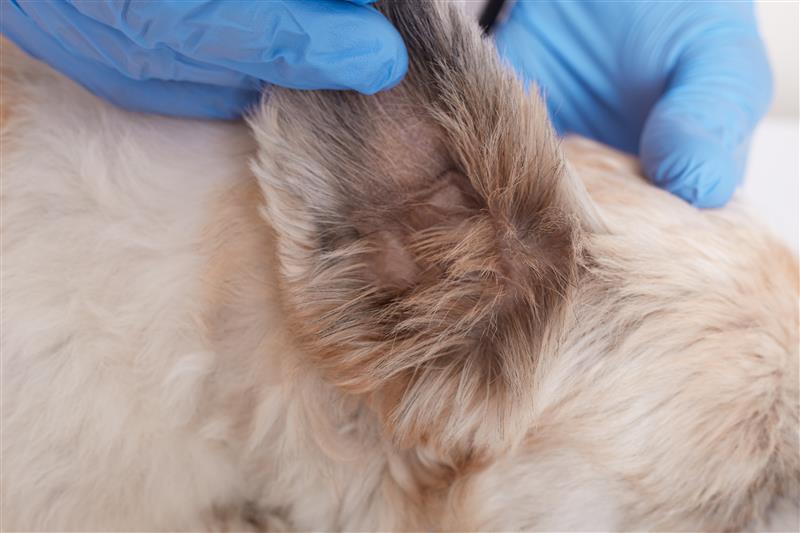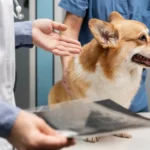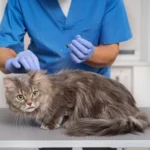
Contents
Skin infections in pets are a common problem that can cause significant discomfort, pain, and distress. From itching to sores, these infections can range from mild and treatable to serious and requiring urgent care. As pet owners, it’s crucial to recognize the signs of skin infections early to prevent further complications.
In this blog, we’ll discuss how to recognize skin infections in pets, their common causes, how to treat them, and when to seek emergency care for pets. Knowing how to address your pet’s skin problems promptly can ensure their health and comfort.
Common Causes of Skin Infections in Pets
Skin infections in pets can be caused by a variety of factors, including bacteria, fungi, parasites, allergies, or underlying health issues. Below are some common causes of pet skin infections:
- Bacterial Infections (Pyoderma)
Bacterial infections, often referred to as pyoderma, are a common cause of skin issues in pets. This infection can occur when the skin’s natural barrier is broken (e.g., from a scratch, hot spot, or insect bite), allowing bacteria to enter. Symptoms include redness, swelling, pus-filled sores, and excessive licking or scratching. - Fungal Infections (Ringworm)
Ringworm is a fungal infection that affects the skin, hair, and nails of pets. It causes circular patches of hair loss, scaly skin, and sometimes itching. Despite the name, ringworm is not caused by a worm but by a fungus. It is highly contagious, especially in multi-pet households. - Parasite Infestations (Fleas, Mites, Ticks)
Fleas, mites, ticks, and other parasites can cause intense itching and irritation in pets. Flea infestations, in particular, often lead to hot spots (painful, moist, inflamed areas of skin). Mites, such as those responsible for mange, can lead to severe skin infections if left untreated. - Allergies
Allergies to food, environmental factors (like pollen or dust mites), or certain substances (such as shampoo or cleaning products) can lead to itchy, inflamed skin, resulting in secondary bacterial or fungal infections. Pets often scratch or lick excessively, making the situation worse. - Wounds and Hot Spots
Scratches, bites, or wounds can easily become infected, especially if not cleaned properly. A wound may become red, swollen, and filled with pus. Hot spots (moist dermatitis) are another common skin issue, often triggered by scratching or licking an itchy spot on the skin.
Recognizing the Signs of Skin Infections in Pets
It’s essential to recognize the early signs of a skin infection so you can provide timely care. Here are some common symptoms to watch for:
- Excessive Scratching or Licking
Pets with skin infections often scratch, bite, or lick excessively at the affected area. If your pet is continuously focusing on a specific spot, it’s likely that the area is painful or itchy. - Redness or Swelling
Inflamed, red, or swollen skin can be a clear sign of infection. This might appear as patches of skin that are irritated and tender to the touch. - Discharge or Pus
If your pet has a wound or infection, you may notice yellow or green discharge oozing from the area. This is often a sign of a bacterial infection, and it’s important to seek treatment as soon as possible. - Hair Loss
Infections like ringworm or flea infestations can cause patches of hair loss. The skin underneath may be dry, scaly, or even have sores. - Bad Odor
An unpleasant smell emanating from your pet’s skin could indicate a bacterial infection, which often has a foul odor. This is especially common in areas where the pet has been licking or scratching constantly. - Crusts, Scabs, or Sores
If you see crusty patches, scabs, or open sores on your pet’s skin, it’s likely the result of an infection. These can occur when your pet’s natural defenses against bacteria or fungi are compromised by scratching or licking.
How to Treat Skin Infections in Pets
If you notice any of the symptoms listed above, here are the steps to take to treat a skin infection in pets:
- Consult Your Vet
The first and most important step in treating a skin infection is to consult your vet. They will be able to diagnose the cause of the infection and recommend appropriate treatment, whether it’s antibiotics, antifungal medications, or topical treatments. - Follow Prescribed Medications
For bacterial or fungal infections, your vet may prescribe antibiotics or antifungal creams or shampoos. Be sure to follow the treatment plan exactly as prescribed and finish the full course of medication, even if your pet starts to feel better. - Clean the Affected Area
Gently clean the infected area with a mild antiseptic or as recommended by your vet. Keep the area dry and avoid using harsh chemicals that can irritate the skin further. - Prevent Further Scratching or Licking
If your pet is constantly scratching or licking the infected area, consider using an Elizabethan collar (cone) or pet booties to prevent them from irritating the infection. This will allow the skin to heal faster and reduce the risk of worsening the infection. - Hydrate and Support Overall Health
Ensure your pet stays hydrated and maintains a balanced diet to support their immune system. A strong immune system will help them fight off the infection more effectively.
When to Seek Emergency Care for Pets
While many skin infections can be treated with the help of your vet, some situations require emergency care. Seek urgent veterinary attention if:
- The infection is spreading rapidly or the wound is worsening.
- The area becomes excessively painful or your pet shows signs of severe distress.
- There’s excessive swelling or difficulty breathing (this could indicate an allergic reaction to the infection).
- The infection doesn’t improve after a few days of treatment.
- Your pet shows signs of systemic infection, such as fever, lethargy, or vomiting.
Preventing Skin Infections in Pets
Preventing skin infections starts with proactive care. Here are some tips to reduce your pet’s risk of developing skin issues:
- Regular Grooming: Brush your pet regularly to prevent matting, reduce shedding, and spot potential skin problems early.
- Flea and Tick Prevention: Use flea and tick preventatives to avoid parasitic infestations that can lead to skin issues.
- Keep Your Pet Clean and Dry: After walks or outdoor play, wipe down your pet’s paws and coat to remove dirt, moisture, or allergens.
- Healthy Diet: Ensure your pet is on a nutritious, well-balanced diet to support a healthy coat and skin.
- Avoid Allergens: If your pet has known allergies, work with your vet to identify triggers and minimize exposure.
Conclusion
Recognizing and treating skin infections in pets promptly is key to preventing complications and ensuring your pet’s well-being. If your pet shows signs of a skin issue, don’t hesitate to consult your vet. With proper treatment and preventive care, your pet can enjoy healthy, comfortable skin.
At North MS Pet Emergency, we are ready to provide emergency care for pets suffering from skin infections and other health issues. If your pet requires immediate care, contact us today.
Contact us now for expert care, or visit us for emergency care for pets after hours.




